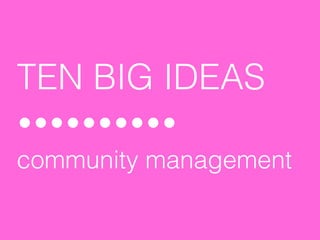10 big ideas about Community Management
- 1. TEN BIG IDEAS ’é¤’é¤’é¤’é¤’é¤’é¤’é¤’é¤’é¤’é¤ community management
- 5. ’é¤’é¤’é¤’é¤’é¤’é¤’é¤ It takes a village.
- 6. ’é¤’é¤’é¤’é¤’é¤’é¤ Sharing is caring. (Your team canŌĆÖt ’¼üx what they donŌĆÖt know is broken.)
- 7. ’é¤’é¤’é¤’é¤’é¤ If you donŌĆÖt care, why should your community?
- 8. ’é¤’é¤’é¤’é¤ You are not a robot. Act human.
- 12. Marisa Peacock ’é¤’é¤’é¤’é¤’é¤’é¤’é¤’é¤’é¤’é¤ The Strategic Peacock @marisacp51
Editor's Notes
- #2: \n
- #3: Your community is global, available 24 hours a day. Don’t limit your engagement to 9-5 or Standard Eastern Time. Be prepared to manage and monitor activity when it’s convenient for your fans, not you. Create a team that can work in real time across time zones. Schedule posts that all members of your community can read over their morning coffee, lunch breaks and after work, no matter where they live. \n
- #4: A community doesn’t form overnight. It needs to be cultivated. You can’t force engagement. It’s said that social media engagement is like dating. Don’t expect to pop the question on the first date. Take the time to get to know your fans and they will invest time your brand. \n\nCreate a strategy that incorporates accelerated growth as well as plateaus. You can’t expect to grow consistently, but you can plan how you will cultivate and engage the fans you have, when you have them. \n\n
- #5: Your CEO wants 1 million fans. Who doesn’t? But you’ll soon find by engaging 100 loyal fans, your reach and influence will grow faster than buying 1 million likes. \n\nMuch like any community, 20% will do 80% of the work. Pay attention to those that are actively engaging with you – leverage their enthusiasm and commitment to help you build your brand. \n\n
- #6: Community management shouldn’t exist exclusively within one department.\n\nEvery one is a community manager whether it’s in your job description or not. Empower employees to engage and contribute across platforms as necessary. \n\nAllow employees the opportunity to solve customer issues on their own. You can’t and shouldn’t manage a community by yourself. Input from all departments can help provide valuable information and insights that can benefit users. \n
- #7: Your users have great ideas, questions and comments. Don’t keep them to yourself. Share user feedback with colleagues so they can fix what’s broken and use feedback to innovate. Don’t create a community silo – rather integrate user communities into organizational culture and infrastructure. While not every user-generated idea needs to result in a company action, your users need to know which actions resulted from their feedback. \n\n
- #8: If you don’t put in the effort to engage, how can you expect the same of your users? Sincerity breeds positive feelings in the people around you. No matter how inane or annoying questions can be, it’s important to remain calm and carry on. \n\nThough caring about your brand and its impact in the universe is important, don’t take yourself too seriously. Arrogance breeds alienation and in some cases, disaster. \n\n
- #9: Engage with users in a voice authentic to your brand. Reminding your community that there are people behind the brand can help humanize and create empathy, which is particularly helpful when mistakes are made. Research from Maritz indicates that simply responding can make a significant difference to the consumer’s opinion of the brand, especially for younger consumers. 58% of those surveyed in the study had a higher opinion of a company than before as a result of them responding to an inquiry. \n\nIf several team members manage a community, identify yourself. Personas can help users relate to you and your brand, which can help build trust. As cool as robots are, people trust humans more to listen to their issues and solve their problems.\n
- #10: Thanks to apps like Buffer and If This Than That, there are many ways you can create and execute repetitive tasks so you can focus more time on engaging and managing your community. \n\nCreate alerts so you can be notified when someone mentions you, posts to your wall or writes about you on their blog. Create tasks that add active followers to a Twitter list. However, there are things you can automate that you probably shouldn’t – like auto direct messages or instant follow backs or posting Tweets to Facebook. Streamline tasks that are meaningful and add value.\n
- #11: It is tempting to get your fans to jump through hoops to win rewards or perks. However, any task or engagement with your brand should add value, not work to the customer experience. As your community evolves, it’s essential to ask yourself what’s in it for them?\n\nConversely, anything you ask of your community members should create value for your company. Don’t ask questions for the sake of asking. Ask questions that lend insight for products, services and marketing messages. \n\n
- #12: Don’t treat the customers who walk through your door, email you or call on the phone any differently than your online community. Every touch point is an opportunity to engage and create positive interactions. \n\nDevelop content that reflects a consistent voice and persona. Don’t be personable online and unhelpful on the phone. Integrate customer relations management systems that reflect a customer’s interactions online and off so that employees can best understand where they’ve been and what they need. \n
- #13: \n












